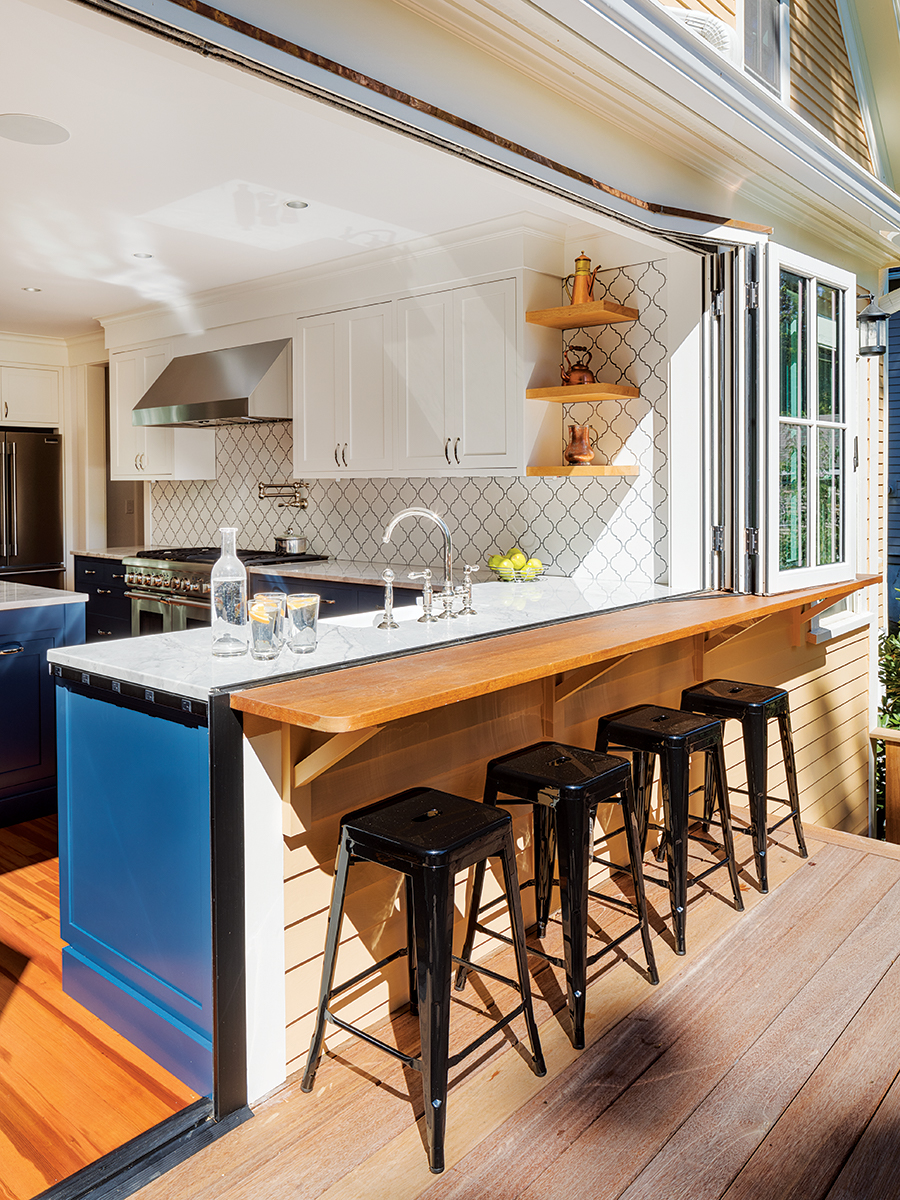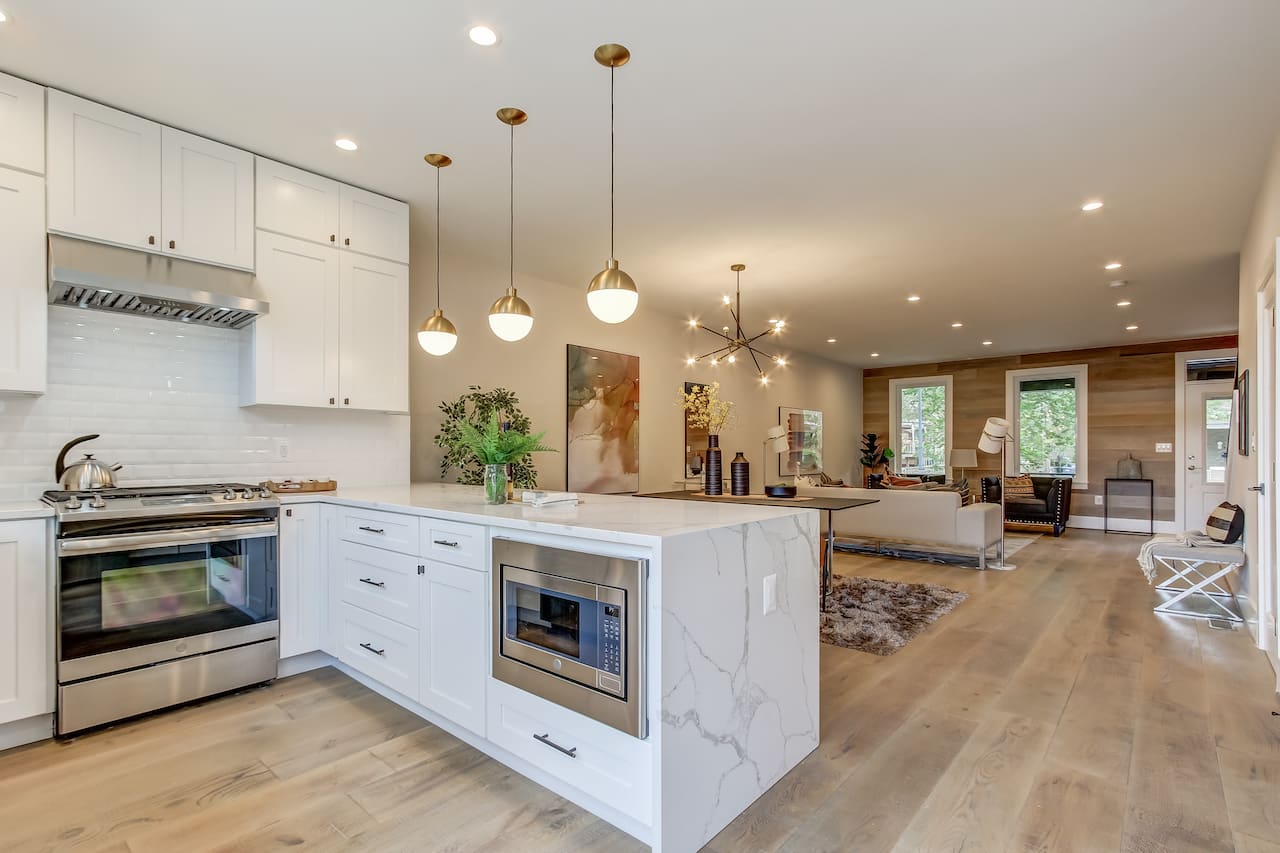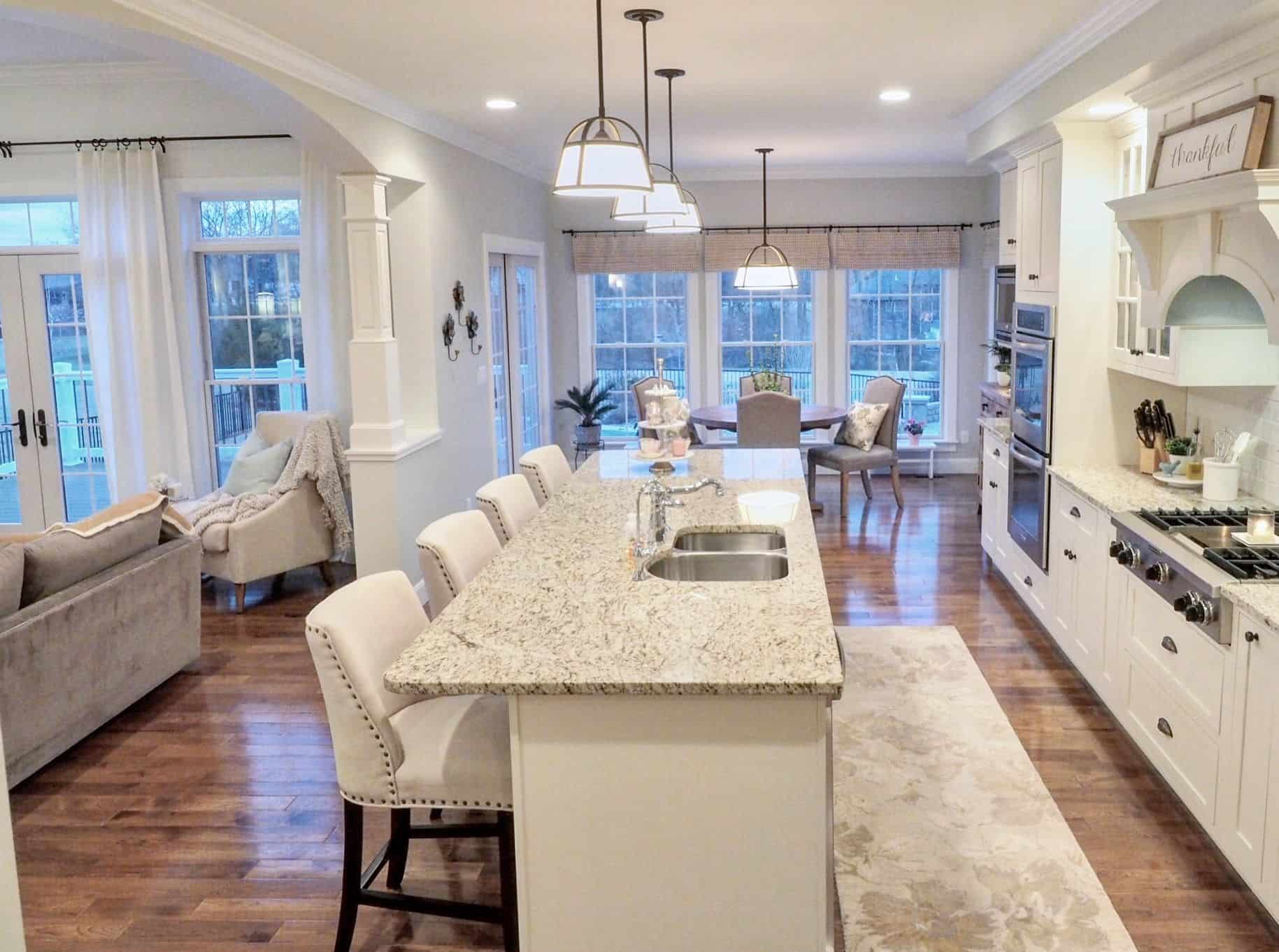Open Concept Kitchen: Where Food & Life Blend Seamlessly
Open Concept Kitchen: Where Food & Life Blend Seamlessly
The heart of any home, the kitchen is a space where meals are prepared, families gather, and memories are made. In recent years, the open concept kitchen has gained immense popularity, transforming this traditional space into a dynamic hub that seamlessly integrates with the rest of the home. This article delves into the captivating world of open concept kitchens, exploring their advantages, design considerations, and how they can create a truly harmonious living experience.

The Allure of Open Concept Living
Open concept living embodies a philosophy of interconnectedness, breaking down physical barriers between spaces to foster a sense of openness, flow, and unity. In the context of kitchens, this translates to an expansive space that welcomes light, visually connects with adjacent areas, and encourages interaction and engagement.
Advantages of Open Concept Kitchens:
- Enhanced Social Interaction: The absence of walls fosters a sense of community and encourages lively conversations during meal preparation and gatherings. Guests can feel included in the culinary experience, making cooking more enjoyable and sociable.
- Increased Natural Light: By eliminating walls, open concept kitchens embrace natural light, creating a bright and airy atmosphere that promotes a sense of spaciousness and well-being.
- Visual Flow and Continuity: Open concept design creates a sense of visual flow, connecting the kitchen with other areas like the living room or dining room. This seamless transition creates a cohesive and inviting ambiance, ideal for entertaining and everyday living.
- Enhanced Functionality: Open concept kitchens often feature a large central island, providing ample workspace for cooking and dining. This multi-functional space serves as a gathering spot, a breakfast bar, and a staging area for food preparation.
- Versatility and Flexibility: The open design allows for greater flexibility in furniture arrangement, catering to different needs and activities. The open space can be easily adapted for various purposes, such as hosting large gatherings or creating cozy intimate settings.
Designing Your Dream Open Concept Kitchen:
While the allure of open concept kitchens is undeniable, careful planning and design are essential for maximizing its potential. Here are some key considerations for crafting a functional and aesthetically pleasing space:

1. Defining the Layout:
- Island or Peninsula: A central island or peninsula is often the focal point of an open concept kitchen, providing extra workspace, seating, and storage. Consider the size and shape of your space to determine the ideal configuration.
- Traffic Flow: Optimize traffic flow by creating clear pathways through the kitchen and surrounding areas. Avoid placing obstacles or furniture that could impede movement.
- Clear Zones: Define distinct areas for cooking, dining, and socializing. This helps to create a sense of order and prevent clutter.
2. Selecting Materials and Finishes:
:max_bytes(150000):strip_icc()/181218_YaleAve_0175-29c27a777dbc4c9abe03bd8fb14cc114.jpg)
- Color Palette: Opt for a cohesive color palette that complements the overall design of your home. Consider using neutral colors for walls and cabinetry, with accents of color in furniture, appliances, and accessories.
- Countertops and Backsplash: Choose durable and easy-to-clean materials for countertops and backsplashes. Popular options include granite, quartz, stainless steel, and butcher block.
- Cabinets and Storage: Select cabinetry that maximizes storage space and complements the style of your kitchen. Consider open shelving for a modern look, or closed cabinets for a more traditional aesthetic.
- Flooring: Choose durable flooring that can withstand heavy foot traffic and spills. Popular choices include hardwood, tile, laminate, or engineered wood.
3. Lighting and Ventilation:
- Natural Light: Maximize natural light by incorporating large windows or skylights. Strategically placed windows can illuminate the kitchen while offering stunning views of the outdoors.
- Artificial Lighting: Install a combination of ambient, task, and accent lighting to create a balanced and functional illumination system. Under-cabinet lighting can illuminate workspaces, while pendant lights can add a decorative touch.
- Ventilation: Ensure adequate ventilation to remove cooking odors and steam. Consider installing a range hood with a powerful fan and a ventilation system that effectively exhausts air outside the home.

4. Addressing Potential Drawbacks:
- Noise Control: While open concept design promotes flow and connection, it can also amplify noise levels. Consider using sound-absorbing materials, such as carpets or rugs, to minimize sound reverberation.
- Privacy Concerns: Open concept kitchens may compromise privacy, especially if you prefer a more intimate setting. Use room dividers, curtains, or strategically placed furniture to create zones of privacy as needed.
- Maintaining Cleanliness: With a larger, more exposed space, keeping a clean and tidy kitchen is essential. Implement organization strategies, utilize cleaning products designed for specific materials, and make cleaning a regular habit.
Embracing Open Concept Living:


Beyond functionality, open concept kitchens offer an opportunity to express personal style and create a truly unique living experience. Embrace these tips to elevate your kitchen design:
- Personal Touches: Incorporate personal touches like artwork, plants, and decorative accessories that reflect your personality and interests.
- Statement Pieces: Add a touch of drama with a statement piece, such as a custom island, unique lighting fixtures, or a bold backsplash.
- Mixing Styles: Don't be afraid to mix different styles and materials to create a unique and dynamic look. For example, you could combine modern cabinetry with rustic countertops or vintage appliances with sleek metal accents.

Open Concept Kitchen: A Symphony of Style and Function


The open concept kitchen is not just a space for preparing meals; it's a platform for fostering connection, celebrating life, and creating memories. By embracing the principles of open design, considering your individual needs, and incorporating personal touches, you can transform your kitchen into a dynamic and inspiring hub that seamlessly blends food and life, creating a truly harmonious living experience.
Open Concept Kitchen Bliss: 5 Ideas to Steal Today!
The open concept kitchen has become a modern-day architectural staple, transforming the way we live, cook, and entertain. Gone are the days of cramped, isolated kitchens. Now, these culinary havens are seamlessly integrated into the heart of the home, fostering a sense of flow, connection, and an inviting ambiance that spills from the kitchen to every corner of your living space.

However, embracing an open concept kitchen design comes with its own set of challenges. The key lies in finding the perfect balance between functionality, aesthetics, and achieving a cohesive flow that enhances your home's overall design.
This article dives into five powerful ideas to steal and implement in your own open concept kitchen, turning it into a sanctuary of culinary delight and social gathering:
1. Flow and Functionality: Creating a Seamless Symphony

An open concept kitchen is all about creating a seamless flow that blends seamlessly with the surrounding living areas. The key is to ensure that the kitchen space seamlessly connects with the adjacent rooms, visually and practically. Here are some key elements to consider:
- Open Shelving: Embrace the open shelving trend, replacing bulky cabinets with sleek, minimalist shelves. Not only does it provide visual lightness, but it also opens up the space, fostering a sense of openness and airiness.
- Island as a Focal Point: A large, well-designed kitchen island becomes the centerpiece of your open concept kitchen. It can be used for food prep, casual dining, and even serving as a bar-style gathering point for your guests.
- Flowing Flooring: The choice of flooring can significantly impact the overall flow of your open concept kitchen. Opt for a consistent material that flows seamlessly from the kitchen into the adjacent living areas. This creates a cohesive visual experience, making the spaces feel interconnected and expansive.
- Strategic Lighting: Lighting plays a crucial role in creating a warm and inviting atmosphere in an open concept kitchen. A combination of ambient lighting, task lighting, and accent lighting can create the perfect balance of mood and functionality. Consider recessed lighting for general illumination, pendant lights above the island for focused task lighting, and accent lighting to highlight architectural features.
2. The Art of Separating Spaces: Defining Boundaries without Walls
While an open concept kitchen embraces openness, it's essential to have subtle ways to define distinct spaces without sacrificing the flow. Here's how to create visual separation:
- Floor Material Transition: A change in flooring material can subtly define the transition between the kitchen and the living room or dining area. For instance, using a wood floor in the living area and a tile floor in the kitchen creates a distinct visual separation.
- Color Schemes: The use of different color schemes can also help delineate areas. You can use lighter colors in the kitchen and a darker color in the adjacent living space, creating a clear visual distinction.
- Strategic Furniture Placement: Placing furniture strategically can also serve as a visual divider. A sofa placed perpendicular to the kitchen island can create a defined separation between the living and dining areas.
- Rugs and Area Carpets: Rugs and area carpets are excellent tools for defining specific areas within your open concept kitchen. Use a large rug to anchor the dining area or place a smaller rug beneath the kitchen island to create a distinct zone.
3. Kitchen Cabinetry: Form Meets Function

Cabinets play a vital role in an open concept kitchen, offering essential storage and enhancing the overall aesthetic. Choosing the right cabinetry style, finish, and materials is crucial for maintaining functionality and aesthetics.
- Open Shelving and Glass Fronts: Combining open shelving with cabinets that feature glass fronts offers a balance between visual lightness and practical storage. This allows you to showcase your favorite kitchenware while keeping other items neatly tucked away.
- Choosing the Right Color Palette: Light-colored cabinets can create an airy feel, reflecting light and making the space feel larger. Darker cabinets can add a sophisticated touch, grounding the design and creating a sense of coziness.
- Integrated Appliances: Integrating your appliances within the cabinetry design is a modern and minimalist approach. This streamlines the overall aesthetic, creating a seamless and sophisticated look.
4. Countertop Magic: Choosing the Right Material
:max_bytes(150000):strip_icc()/181218_YaleAve_0175-29c27a777dbc4c9abe03bd8fb14cc114.jpg)
Countertops are the heart of any kitchen, serving as a work surface, a dining space, and a focal point. Choosing the right countertop material is critical for both aesthetics and functionality.
- Natural Stone: Granite, marble, and quartz are classic and elegant choices, offering durability, beauty, and a timeless appeal.
- Wood: A wood countertop adds warmth and a natural touch to the kitchen, creating a rustic and inviting ambiance.
- Concrete: Concrete countertops are a modern and industrial choice, offering a unique and edgy appeal.
- Laminate: Laminate is a budget-friendly option, available in a wide variety of colors and patterns, offering a durable and practical solution.
5. Backsplash: A Splash of Personality

The backsplash is an opportunity to add personality and visual interest to your open concept kitchen. A well-chosen backsplash can transform the space, complementing your overall design aesthetic.
- Subway Tile: Subway tile is a timeless and classic choice, offering a clean and modern look. It's available in various colors and finishes, making it easy to customize to your style.
- Mosaic Tile: Mosaic tile adds a touch of artistry and texture to the backsplash. Choose from various patterns and colors to create a statement piece.
- Natural Stone: Natural stone backsplashes like marble or granite add elegance and sophistication to the kitchen. Their unique veining and patterns create a captivating backdrop.
- Metal or Glass: Metal or glass backsplashes offer a modern and contemporary feel. Metal options create a sleek and industrial vibe, while glass provides a reflective surface that can amplify the light in the space.
Embracing the Open Concept Kitchen

An open concept kitchen is not merely a design trend, it's a way of life. It fosters a sense of openness, connection, and a warm and inviting ambiance that permeates the entire home. By implementing these five ideas, you can transform your kitchen into a haven of culinary delight and social gathering, where memories are made and laughter echoes through the heart of your home.
Additional Tips for Creating Open Concept Kitchen Bliss:

- Consider the Layout: Plan the layout of your kitchen carefully, ensuring that the work triangle (between the sink, stove, and refrigerator) is functional and efficient.
- Incorporate Seating: Include seating options within the kitchen space, such as bar stools at the island or a cozy breakfast nook.
- Maximize Natural Light: Allow natural light to flood the kitchen by incorporating large windows and skylights.
- Embrace a Multi-Functional Space: Design your open concept kitchen to accommodate multiple uses, such as cooking, dining, entertaining, and even working from home.
- Don't Forget the Details: Small details, like a statement pendant light, colorful accessories, or fresh flowers, can make a big difference in creating a welcoming and inviting atmosphere.


Remember: The beauty of an open concept kitchen lies in its flexibility. You can customize the space to suit your individual needs and preferences, creating a unique and personal sanctuary that reflects your style and personality.

